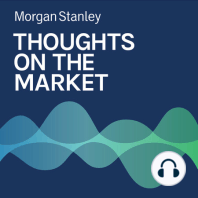3 min listen
Special Episode: The Next Phase of ESG
ratings:
Length:
9 minutes
Released:
Jul 20, 2022
Format:
Podcast episode
Description
Interest in ESG investing has risen exponentially in recent years, leading to increased scrutiny around, and appreciation for, the hard data. Head of U.S. Public Policy Research and Municipal Strategy Michael Zezas and Head of the ESG Fixed Income Research Team Carolyn Campbell discuss.-----Transcript-----Michael Zezas: Welcome to Thoughts on the Market. I'm Michael Zezas, head of U.S. Public Policy Research and Municipal Strategy. Carolyn Campbell: And I'm Carolyn Campbell, head of the ESG fixed income research team at Morgan Stanley. Michael Zezas: And on this special edition of the podcast, we'll be assessing the next phase of the environmental, social, governance, ESG, market. It's Wednesday, July 20th, at 10 a.m. in New York. Michael Zezas: As some listeners may have read, in late May of this year, the Securities and Exchange Commission proposed new rules that would require ESG funds to disclose their goals, criteria and strategies, along with data measuring ESG progress. And this tells us that although the market for ESG investing has grown, so has investor desire to see real data and empirical analysis on impact. And this could be seen as really the next phase of the ESG market, that companies and funds won't just claim to be focused on ESG but will provide real proof. So, Carolyn, just to set the stage, I notice that people sometimes use the term sustainable investing and ESG interchangeably. So, I think it might be good to start with what exactly ESG is. Carolyn Campbell: At its core ESG is about adding a new lens to risk management in our investment practices by looking at environmental, social and governance factors in addition to our traditional financial metrics and whatnot. ESG has been around in some way, shape or form for decades, beginning with what we call negative exclusions. Initially, that looked like excluding companies that conflicted with religious views such as gambling, alcohol or pornography. But it's probably best known more recently for what we would think of as the fossil fuel divestment movement; selling out of coal and oil and gas companies, for example. On the other end of the spectrum, we've got impact investing where money is put towards projects that are both worthy financial investments but are also meant to generate some type of positive impact, whether it be environmental or social. In between, ESG can look like a lot of things, whether that's selecting companies that are best in class or building a portfolio geared towards a certain theme like biodiversity, net zero or gender diversity. Michael Zezas: Now, you're a fixed income strategist and ESG investing through the bond market is a bit newer and still evolving. What are some of the challenges of investing in ESG through bonds as opposed to stocks? Carolyn Campbell: Well, so one big difference in fixed income is that there are products that are actually dedicated sustainability assets. Companies, governments and super nationals can issue bonds that are specifically ESG instruments, which isn't something that you can quite do in the stock market. The most common is the green bond. The net proceeds of the issuance go towards green projects, which can be things like retrofitting your buildings to be more energy efficient, building out a solar paneled roof, reducing water waste and so on. There are also social bonds with projects related to decreasing inequality or access to health care and sustainability bonds, which fund both types of projects. We spend a lot of time trying to understand how these instruments trade compared to normal vanilla bonds from the same issuer. A big driver of the difference in price and performance is that there are just a lot fewer of these label bonds and quite a large appetite to invest in them. So those supply and demand dynamics have historically helped these labor bonds trade well, particularly in the primary market. We recently completed some analysis, though, that found that when you strip away a lot of
Released:
Jul 20, 2022
Format:
Podcast episode
Titles in the series (100)
Mike Wilson: How Confident Are U.S. Businesses in the Economy? by Thoughts on the Market
